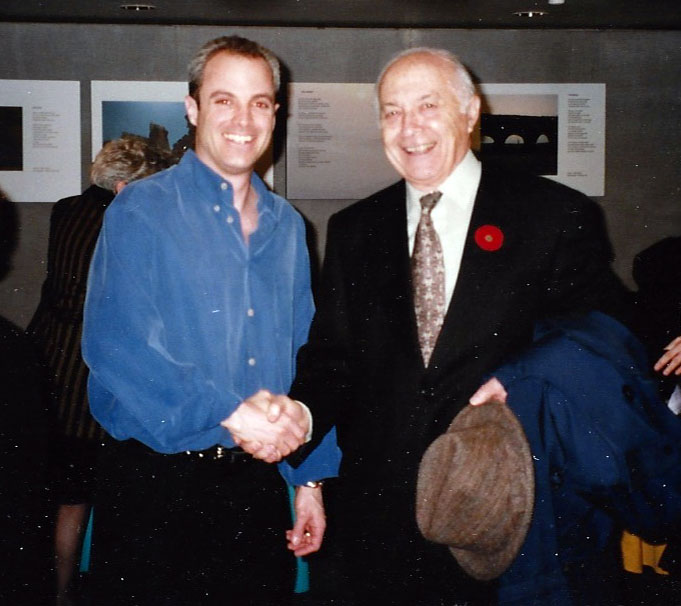THE EXHIBIT: A SEED IN THE POCKET OF THEIR BLOOD
Exploring issues of Jewish identity by combining poetry & photography into one artistic unit
Rafi with his father at the opening of the exhibit in Toronto in November, 1997.
The traveling exhibit, A Seed in the Pocket of Their Blood, explores issues of Jewish identity by combining poetry and photography into one artistic unit. The exhibit has been viewed throughout Canada, with showings in the United States and Israel. A Seed in the Pocket of Their Blood features the work of legendary Time Magazine photographer David Rubinger; Jim Hollander, the former Chief Photographer for Reuters in the Middle East; renowned Montreal photographer Serge Clément and acclaimed Toronto portrait photographer, Ruth Kaplan. The exhibit has a companion book with the same name (for more on the book, the curatorial process, and a complete list of participating photographers see Poetry.)
In August 1998 A Seed in the Pocket of Their Blood was showcased at The Israel at 50 Pavilion at The Canadian National Exhibition in Toronto. Following an invitation from the Canadian Ambassador to Tel Aviv A Seed in the Pocket of Their Blood was viewed in Israel in 1999. The exhibit debuted in the United States at the Klutznick Jewish National Museum in Washington D.C., in February 2000, with an evening sponsored by The Canadian Embassy. This marked the first time a Canadian exhibit had been viewed in the Museum. That night I felt a sense of great satisfaction having brought so many fine Canadian artists to the United States. A Seed in the Pocket of Their Blood has been displayed in museums, at book fairs, and such public spaces as The Rotunda at Metro Hall in Toronto.
A Seed in the Pocket of Their Blood examines the themes of: Jewish Life in Europe, the Holocaust, Jewish immigration to North America and love and war in the land of Israel. Each exhibit board features one photograph and one of my poems. The sole criteria for matching a photograph to a poem was that the photograph gives the poem an added dimension or meaning it could not have achieved alone, and vice versa. The result is that one new piece of art is created from two art forms.
It was an emotional reunion for me when A Seed in the Pocket of Their Blood was displayed in the Jewish Museum of Western Canada. My grandfather had lived in Winkler, Manitoba when he arrived in this country from Russia. Later he moved to Ottawa. Two families helped him out tremendously and he would not have survived without them. He asked me if I could meet the children of these families who were then in there mid 60’s, early 70’s, with the eldest being in her 80’s. The Museum contacted these individuals and I met with them and thanked them on behalf of my grandfather.
When the exhibit opened in Israel there was a quite a commotion when David Rubinger arrived. The Canadian Ambassador immediately went over to greet him and so many people were whispering that it became quite loud. He greeted me and then walked around the exhibit and returned to ask who Gaye Jackson was. I explained that she was a photographer based in Toronto and went on to describe her work. David looked at me and said, “What an incredible shot.” The people around me went quiet. After one of the most venerable photographers in the world makes a comment like that what else can anyone say? He was correct— her photograph for “The Chateau” is an incredible shot.
One of Canada’s leading museums initially told me that my concept for this exhibit would never work. Their research showed people only took 15 to 20 seconds at each exhibit piece and it would take audiences far longer if they also had to read a poem. I remember being at The Israel at 50 Pavilion and seeing people waiting patiently in line to view each exhibit piece, and most importantly reading the words.
